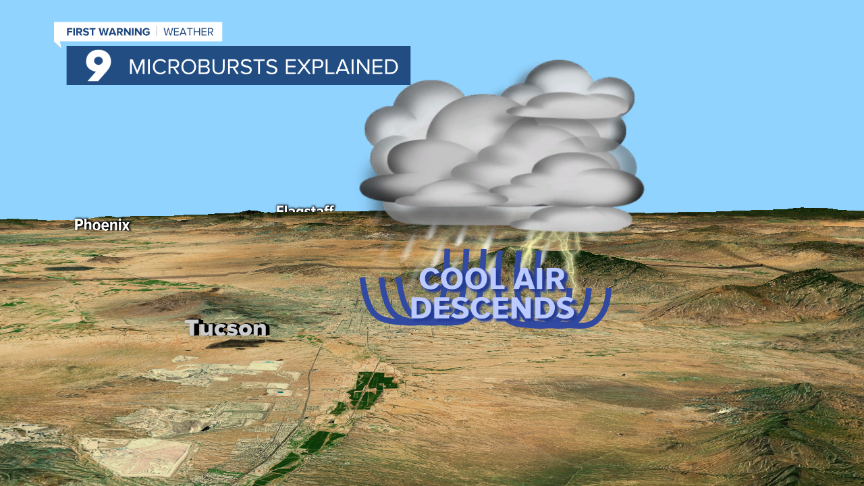TUCSON, Ariz. (KGUN) — During monsoon, one of the most common wind events we see is a microburst. Microbursts are produced by thunderstorms and are capable of producing flooding rain, damaging wind and blinding dust storms. Microbursts are something to be taken seriously, so let's take a little time to learn more about these powerful forces in nature and how they form.
First, let’s talk about a few variations of the same weather phenomenon. There are microbursts and macrobursts. The only difference between a microburst and a macroburst is their size. A microburst is less than two-and-a-half miles in diameter when it reaches the ground. A macroburst is larger than two-and-a-half miles in diameter when it contacts the ground.
There are also wet and dry micro and macrobursts. The only difference between them is whether rain reaches the ground or not. If not, it is known as a dry micro or macroburst.
Now let’s talk about how a microburst forms. The day generally starts out sunny with relatively dry air resting near the surface. Several thousand feet above the surface, enough moisture is available to help create a high-based thunderstorm.

Rain begins to fall from the thunderstorm but evaporates before it reaches the ground because it can't survive the trip through the much drier air near the surface. Even though the rain evaporates before reaching the ground, it rapidly cools the surrounding air.

Cool air sinks and it sinks fast! As the air descends towards the ground, it picks up speed and strength. When the column of air strikes the ground, it fans out in all directions and can bring sudden gusts of wind capable of reaching 100 mph or more.

The leading edge of this wind is known as the outflow boundary or gust front. As the outflow boundary moves along the ground, it blows more dust into the air and creates big dust storms frequently seen on an active monsoon day throughout southern Arizona.

Outflow boundaries also help form new thunderstorms as warm air gets lifted into cooler air. The air condenses and creates clouds that eventually grow into new thunderstorms.
Dust storms created by microbursts are a big threat to drivers as good visibility can be reduced to almost zero visibility in a matter of several feet.
If you encounter a dust storm, slow down and pull off the side of the road as far as you can and still be in a safe place. Turn off your lights and sit out the dust storm while keeping your foot off the brake.

The idea is to not have any lights on because, if you do, other drivers may try to follow your taillights and not realize you're at a complete stop and you take a big risk of being hit from behind. Plus, most dust storms last less than 20 minutes, so it won't be too long before you can be on your way.
Remember, pull aside... Stay alive.
Outflow boundaries create strong wind gusts capable of producing extensive property damage. Many times, people assume their property damage was the result of a microburst. In some cases, this is true.
However, keep in mind, in order to have received damage from a microburst, there must be thunderstorms in the area. Otherwise, the damage was likely the result of a strong gust of wind or a dust devil. No thunderstorms, no microburst.
Microbursts play a big role in our monsoon activity. From a distance, they can be fascinating to observe. However, if caught in or near a microburst, it can quickly turn into a dangerous situation.
Preparation is key to avoiding costly property damage or personal injury. Be sure to secure all loose items and furniture before thunderstorms even begin. Also, pay attention to all watches and warnings. The first warning weather team will keep you up to date on the latest severe weather information via our television, social media and website sources.
As the thunderstorm passes, protect yourself by moving to a place of safety to avoid blowing dust and debris. If taking shelter in a structure, make sure it's sturdy enough to withstand wind that could possibly gust up to 100 mph.

Stay away from trees as they may blow over or large branches may break off and fall to the ground.
Remember to stay far away from any downed power lines and always assume they still have power running through them.
Having a better understanding of the various types of wind events associated with monsoon, and taking the necessary steps to be prepared, will help prevent damage to your property and could potentially save your life when monsoon strikes.



